Ford Trimotor
| Trimotor | |
|---|---|
 | |
| Experimental Aircraft Association (EAA) Ford 4-AT-E Trimotor (2014) | |
| Role | Transport aircraft |
| Manufacturer | Stout Metal Airplane Division of the Ford Motor Company |
| Designer | William Bushnell Stout |
| First flight | June 11, 1926 |
| Introduction | 1926 |
| Status | 18 in existence as of 2012 |
| Primary users | about 100 airlines United States Army Air Corps United States Navy Royal Canadian Air Force |
| Number built | 199 |
| Unit cost |
about $42,000 in 1933 (about $736,000 in 2013) |
| Variants | Stout Bushmaster 2000 |
The Ford Trimotor (also called the "Tri-Motor", and nicknamed "The Tin Goose") is an American three-engined transport aircraft. Production started in 1925 by the companies of Henry Ford and ended June 7, 1933. A total of 199 Ford Trimotors were made.[1] It was designed for the civil aviation market, but also saw service with military units. The Ford Trimotor was sold around the world.
Design and development
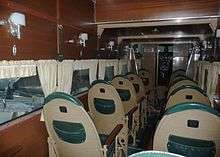
The story of the Ford Trimotor began with William Bushnell Stout, an aeronautical engineer who had previously designed several aircraft using principles similar to, and originally devised by Professor Hugo Junkers, the noted German all-metal aircraft design pioneer.
In the early 1920s, Henry Ford, along with a group of 19 other investors including his son Edsel, invested in the Stout Metal Airplane Company. Stout, a bold and imaginative salesman, sent a mimeographed form letter to leading manufacturers, blithely asking for $1,000 and adding: "For your one thousand dollars you will get one definite promise: You will never get your money back." Stout raised $20,000, including $1,000 each from Edsel and Henry Ford.[2]
In 1925, Ford bought Stout and its aircraft designs. The single-engined Stout design was turned into a multi-engined design, the Stout 3-AT with three Curtiss-Wright air-cooled radial engines. After a prototype was built and test-flown with poor results, and a suspicious fire caused the complete destruction of all previous designs, the "4-AT" and "5-AT" emerged.
The Ford Trimotor using all-metal construction was not a revolutionary concept, but it was certainly more advanced than the standard construction techniques of the 1920s. The aircraft resembled the Fokker F.VII Trimotor (except for being all-metal which Henry Ford claimed made it "the safest airliner around").[3] Its fuselage and wings followed a design pioneered by Junkers[4] during World War I with the Junkers J.I and used postwar in a series of airliners starting with the Junkers F.13 low-wing monoplane of 1920 of which a number were exported to the US, the Junkers K 16 high-wing airliner of 1921, and the Junkers G 24 trimotor of 1924. All of these were constructed of aluminum alloy, which was corrugated for added stiffness, although the resulting drag reduced its overall performance.[5] So similar were the designs that Junkers sued and won when Ford attempted to export an aircraft to Europe.[6] In 1930, Ford countersued in Prague, and despite the possibility of anti-German sentiment, was decisively defeated a second time, with the court finding that Ford had infringed upon Junkers' patents.[6]
Although designed primarily for passenger use, the Trimotor could be easily adapted for hauling cargo, since its seats in the fuselage could be removed. To increase cargo capacity, one unusual feature was the provision of "drop-down" cargo holds below the lower inner wing sections of the 5-AT version.[3][7]
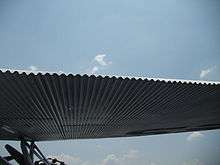
One 4-AT with Wright J-4 200-hp engines was built for the U.S. Army Air Corps as the C-3, and seven with Wright R-790-3 (235 hp) as C-3As. The latter were upgraded to Wright R-975-1 (J6-9) radials at 300 hp and redesignated C-9. Five 5-ATs were built as C-4s or C-4As.
The original (commercial production) 4-AT had three air-cooled Wright radial engines. It carried a crew of three: a pilot, a copilot, and a stewardess, as well as eight or nine passengers [N 1].[3] The later 5-AT had more powerful Pratt & Whitney engines. All models had an aluminum corrugated sheet-metal body and wings. Unlike many aircraft of this era, extending through World War II, its control surfaces (ailerons, elevators, and rudders) were not fabric-covered, but were also made of corrugated metal. As was common for the time, its rudder and elevators were actuated by wires that were strung along the external surface of the aircraft. Engine gauges were also mounted externally, on the engines, to be read by the pilot while looking through the aircraft windshield.[3] Another interesting feature was the use of the hand-operated "Johnny brake." [8]
Like Ford cars and tractors, these Ford aircraft were well-designed, relatively inexpensive, and reliable (for the era). The combination of a metal structure and simple systems led to their reputation for ruggedness. Rudimentary service could be accomplished "in the field" with ground crews able to work on engines using scaffolding and platforms.[5] To fly into otherwise-inaccessible sites, the Ford Trimotor could be fitted with skis or floats.[5]
The rapid development of aircraft at this time (the vastly superior Douglas DC-2 was first conceived in 1932), along with the death of his personal pilot, Harry J. Brooks, on a test flight, led to Henry Ford's losing interest in aviation. While Ford did not make a profit on its aircraft business, Henry Ford's reputation lent credibility to the infant aviation and airline industries, and Ford helped introduce many aspects of the modern aviation infrastructure, including paved runways, passenger terminals, hangars, airmail, and radio navigation.[1] [N 2]
In the late 1920s, the Ford Aircraft Division was reputedly the "largest manufacturer of commercial airplanes in the world." [9] Alongside the Ford Trimotor, a new single-seat commuter aircraft, the Ford Flivver or "Sky Flivver" had been designed and flown in prototype form, but never entered series production.[9] The Trimotor was not to be Ford's last venture in aircraft production. During World War II, the largest aircraft manufacturing plant in the world was built at the Willow Run, Michigan plant, where Ford produced thousands of B-24 Liberator bombers under license from Consolidated Aircraft.[10]
William Stout left the Metal Airplane division of the Ford Motor Company in 1930. He continued to operate the Stout Engineering Laboratory, producing various aircraft. In 1954, Stout purchased the rights to the Ford Trimotor in an attempt to produce new examples. A new company formed from this effort brought back two modern examples of the trimotor aircraft, renamed the Stout Bushmaster 2000, but even with improvements that had been incorporated, performance was judged inferior to modern designs.
Operational history
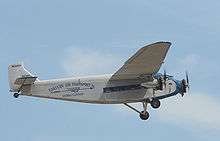
A total of 199 Ford Trimotors were built between 1926 and 1933, including 79 of the 4-AT variant, and 116 of the 5-AT variant, plus some experimental craft. Well over 100 airlines of the world flew the Ford Trimotor.[1] From mid-1927, the type was also flown on executive transportation duties by several commercial nonairline operators, including oil and manufacturing companies.
The impact of the Ford Trimotor on commercial aviation was immediate, as the design represented a "quantum leap over other airliners." [11] Within a few months of its introduction, Transcontinental Air Transport was created to provide coast-to-coast operation, capitalizing on the Trimotor's ability to provide reliable and, for the time, comfortable passenger service. While advertised as a transcontinental service, the airline had to rely on rail connections with a deluxe Pullman train that would be based in New York being the first part of the journey. Passengers then met a Trimotor in Port Columbus, Ohio, that would begin a hop across the continent ending at Waynoka, Oklahoma, where another train would take the passengers to Clovis, New Mexico, where the final journey would begin, again on a Trimotor, to end up at the Grand Central Air Terminal in Glendale, a few miles northeast of Los Angeles.[11] This demanding trip would be available only for a year before Transcontinental was merged into a combine with Western Air Service.
Ford Trimotors were also used extensively by Pan American Airways, for its first international scheduled flights from Key West to Havana, Cuba, in 1927. Eventually, Pan American extended service from North America and Cuba into Central and South America in the late 1920s and early 1930s.[12] One of Latin America's earliest airlines, Cubana de Aviación, was the first to use the Ford Trimotor in Latin America, starting in 1930, for its domestic services.
The heyday for Ford's transport was relatively brief, lasting only until 1933, when more modern airliners began to appear. Rather than completely disappearing, the Trimotors gained an enviable reputation for durability with Ford ads in 1929 proclaiming, "No Ford plane has yet worn out in service."[12] First being relegated to second- and third-tier airlines, the Trimotors continued to fly into the 1960s, with numerous examples being converted into cargo transports to further lengthen their careers, and when World War II began, the commercial versions were soon modified for military applications.
Some of the significant flights made by the Ford Trimotor in this period greatly enhanced the reputation of the type for strength and reliability. One example was Ford 4-AT Trimotor serial number 10, built in 1927. It flew in the United States and Mexico under registration number C-1077, and for several years in Canada under registration G-CARC. It had many notable accomplishments; it was flown by Charles Lindbergh and Amelia Earhart, among many others. It made the first commercial flight from the United States to Mexico City, as well as the first commercial flight over the Canadian Rockies. After damage on landing in 1936, it was grounded and remained for decades at Carcross, Yukon. In 1956, the wreck was salvaged and preserved, and in the mid 1980s, Greg Herrick took over C-1077 and began restoring it. As of 2006, C-1077 is in flying condition again, restored to its December 1927 appearance.[1]
Making headlines became a Trimotor trademark. On November 27 and 28, 1929, Commander Richard E. Byrd (navigator), chief pilot Bernt Balchen, and two other crewmen, the copilot and the photographer, made the first flight above the geographic South Pole in a Ford Trimotor that Byrd named the Floyd Bennett. This was one of three aircraft taken on this polar expedition, with the other two being named The Stars and Stripes and The Virginian, replacing the Fokker Trimotors that Byrd previously used.[5]
A Ford Trimotor was used for the flight of Elm Farm Ollie, the first cow to fly in an aircraft and to be milked mid-flight.[13]
Franklin Roosevelt also flew aboard a Ford Trimotor in 1932 during his presidential campaign in one of the first uses of an aircraft in an election, replacing the traditional "whistle stop" train trips.[14]
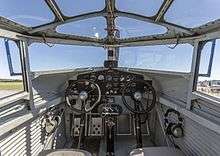
The short-range capabilities of the Ford Trimotor were exploited in a search for the lost flyers of the Sigizmund Levanevsky trans-polar flight in 1937. Movie stunt flyer Jimmie Mattern flew a specially modified Lockheed Electra along with fellow movie flyer, Garland Lincoln, flying a stripped-down Trimotor donated by the president of Superior Oil Company. With 1,800 gallons of avgas and 450 gallons of oil in the modified cabin, the Trimotor was intended to act as a "tanker" for the expedition. The Electra was able to transfer fuel in the air from the Trimotor, through a hose cast out the 4-AT's door. With the first aerial refueling test successful, the pair of pilots set out for Fairbanks, landing first at Burwash Landing, Yukon Territory, Canada, on August 15, 1937, but the Trimotor ran out of fuel and crashed in inclement weather the following day. The Trimotor was abandoned on the tundra.[15]
One of the major uses of the Trimotor after it was superseded as a passenger aircraft by more modern aircraft like the DC-3, was the carrying of heavy freight to mining operations in jungles and mountains. The Trimotor was employed for decades in this role.[16]
In 1942, during the Battle of Bataan, a Trimotor was used in evacuations. The aircraft would haul 24 people nearly 500 miles a trip, twice daily. The aircraft was eventually strafed and destroyed by Japanese aircraft.[17]
In postwar years, the Ford Trimotors continued in limited service with small, regional air carriers. One of the most famous was the Scenic Airways Ford Trimotor N414H which was used for 65 years as a sightseeing aircraft flying over the Grand Canyon.[3] The aircraft is still in use as of late 2011, mainly for promotional and film work, though one Trimotor operator offers rides. As of October 2016, a Ford Trimotor was still being used by the Experimental Aircraft Association (EAA) to fly passengers on sightseeing tours.
Variants
- Ford 3-AT
- The original Stout prototype; one built.
- Ford 4-AT
- Pre-production prototype, powered by three 200-hp (150-kW) Wright J-4 Whirlwind radial piston engines, accommodation for two pilots and eight passengers; one built.
- Ford 4-AT-A
- The original production version, similar to the Ford 4-AT prototype; 14 built.
- Ford 4-AT-B
- Improved version, powered by three 220-hp (165-kW) Wright J-5 Whirlwind radial piston engines, accommodation for two pilots and 12 passengers; 39 built.
- Ford 4-AT-C
- Similar to the Ford 4-AT-B, equipped with a 400-hp (300-kW) Pratt & Whitney Wasp radial piston engine, fitted in the nose of the aircraft; one built.
- Ford 4-AT-D
- Three aircraft similar to the Ford 4-AT-B, each with different engines and minor modifications.
- Ford 4-AT-E
- Similar to the Ford 4-AT-B, powered by three 300-hp (225-kW) Wright J-6-9 Whirlwind nine-cylinder radial piston engines; 24 built.
- Ford 4-AT-F
- One aircraft similar to the Ford 4-AT-E.
- Ford 5-AT-A
- Enlarged version, powered by three 420-hp (320-kW) Pratt & Whitney Wasp radial piston engines, accommodation for two pilots and 13 passengers, the wingspan was increased by 3 ft 10 in (1.17 m); three built.
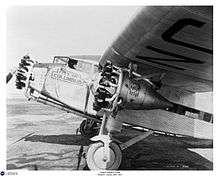
- Ford 5-AT-B
- Similar to the Ford 5-AT-A, powered by 420-hp Pratt & Whitney Wasp C-1 or SC-1 radial piston engines, accommodation for two pilots and 15 passengers; 41 built.
- Ford 5-AT-C
- Improved version, similar to the Ford 5-AT-A, accommodation for two pilots and 17 passengers; 51 built.
- Ford 5-AT-CS
- Seaplane version, fitted with Edo floats; one built.
- Ford 5-AT-D
- Increased-weight version, powered by three 450-hp (340-kW) Pratt & Whitney Wasp SC radial piston engines. The wings were mounted 8 in (20 cm) higher, to increase cabin headroom, but otherwise similar to the Ford 5-AT-C; 20 built.
- Ford 5-AT-DS
- Seaplane version, fitted with Edo floats; one built.
- Ford 5-AT-E
- Proposed version, the engines were relocated to the wing leading edges.
- Ford 6-AT-A
- Similar to the Ford 5-AT-A, powered by three 300-hp Wright J-6-9 radial piston engines; three built.
- Ford 6-AT-AS
- Seaplane version, fitted with Edo floats; one built.
- Ford 7-AT-A
- Redesignation of a single Ford 6-AT-A, equipped with a 420-hp Pratt & Whitney Wasp radial piston engine, fitted in the nose of the aircraft.
- Ford 8-AT
- One Ford 5-AT-C converted into a single engine freight transport aircraft. Six different engines ranging from 575 hp (429 kW) to 700 hp (520 kW) were installed.[18]
- Ford 9-AT
- Redesignation of a single Ford 4-AT-B, fitted with three 300-hp Pratt & Whitney Wasp radial piston engines.
- Ford 11-AT
- Redesignation of a single Ford 4-AT-E, fitted with three 225-hp Packard DR-980 diesel engines.
- Ford 13-A
- Redesignation of a single Ford 5-AT-D, fitted with two 300-hp Wright J-6-9 Whirlwind radial piston engines, and a 575-hp (430-kW) Wright Cyclone radial piston engine fitted in the nose of the aircraft.
- Ford 14-A
- Large three-engined version, powered by three 1000-hp (750-kW) Hispano-Suiza 18 Sbr piston engines (W engines: 3 x 6 cylinders), accommodation for two pilots and 40 passengers.
- Ford XB-906
- One Ford 5-AT-D was converted into a three-engined bomber aircraft.
United States military designations
- XC-3
- One 4-AT-A evaluated by the United States Army Air Corps, redesignated C-3 after evaluation.[19]
- C-3
- One 4-AT-A was redesignated from XC-3 following evaluation[19]
- C-3A
- Model 4-AT-E a military transport version, powered by three 235-hp Wright R-790-3 Whirlwind radial piston engines; seven built, all later converted to C-9[19]
- C-4
- One 4-AT-B acquired by the military for evaluation[19]
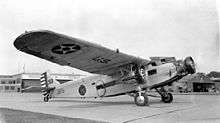
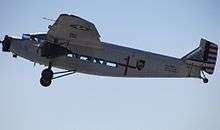
- C-4A
- Military transport version, based on the Ford 5-AT-D, powered by three 450-hp Pratt & Whitney R-1340-11 Wasp piston engines; four built[19]
- C-4B
- One C-4A re-engined with three 450-hp R-1340-7 engines.[19]
- C-9
- Redesignation of all seven C-3As fitted with 300-hp (224 Kw) Wright R-975-1 radial piston engines[20]
- XJR-1
- One Model 4-AT-A for evaluation by the United States Navy[21]
- JR-2
- Military transport version for U.S. Marine Corps, based on the Ford 4-AT-E, but with three Wright J6-9 engines; two built, redesignated RR-2 in 1931[21]
- JR-3
- Military transport version for the U.S. Navy (one) and U.S. Marine Corps (two), based on the Ford 5-AT-C; three built.[21]
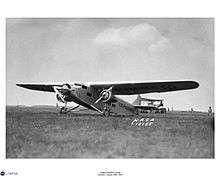
- RR-1
- Redesignation of the XJR-1 prototype[22]
- RR-2
- Redesignation of the JR-2 in 1931[22]
- RR-3
- Redesignation of the JR-3 in 1931[22]
- RR-4
- Designation for one 5-AT-C[22]
- RR-5
- Designation for two 4-AT-D, one each for the U.S. Navy and U.S. Marines[22]
Operators
Civil operators
- BYN Co.(British Yukon Navigation Company) CF-AZB flew in the Yukon from April 1936 until damaged in August 1940.[23]
- Dominicana de Aviación, Dominican Republic airline flew Ford Trimotors in the early 1930s.[24]
- American Airlines
- Grand Canyon Airlines
- Island Airlines, Bass Islands, Ohio
- Pan American World Airways
- Star Air Service
- Texaco
- Transcontinental Air Transport
- Trans World Airlines
- Wien Air Alaska
- United Airlines
Military operators
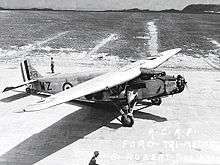
- Royal Air Force
- No. 271 Squadron RAF operated a single 5AT-0 during 1940.[25]
Accidents and incidents
- On March 17, 1929, a Colonial Western Airlines 4-AT-B Tri-Motor, NC7683, suffered a double engine failure during its initial climb after takeoff from Newark Airport in Newark, New Jersey. It failed to gain height and crashed into a railroad freight car loaded with sand, killing 14 of the 15 people on board the aircraft. At the time, it was deadliest aviation accident in American history.[26]
- On April 21, 1929, a Maddux Air Lines 5-AT-B Trimotor, NC9636, collided with a United States Army Air Service (USAAS) Boeing PW-9D fighter, 28-037, over San Diego; all six on board both aircraft died. The pilot of the Boeing PW-9D was performing stunts and then attempted to pass in front of the airliner, but misjudged the speed of the Maddux aircraft and his aircraft struck the cockpit of the Ford Tri-Motor.
- On September 3, 1929, a Transcontinental Air Transport 5-AT-B Tri-Motor, NC9649, named The City of San Francisco, crashed into Mount Taylor near Grants, New Mexico in a thunderstorm; all eight people on board died.
- On January 19, 1930, a Maddux Air Lines 5-AT-C Trimotor, NC9689, and operating as Flight 7, crashed near Oceanside, California due to adverse weather conditions, killing all 16 on board.
- On June 24, 1935, a Tri-Motor 5-AT-B of SACO (Servicio Aéreo Colombiano), registered C-31, collided with a Trimotor of SCADTA (Sociedad Colombo-Alemana de Transportes Aéreos), registered F-31, at Olaya Herrera Airfield near Medellín, Colombia; of the 20 on board both aircraft, only three passengers survived. Among the dead was the tango singer Carlos Gardel.[27]
- On September 25, 2004, a Tri-Motor look alike Bushmaster Aircraft 2000 in Fullerton, California crashed on the tarmac during Airport Appreciation Day.
Surviving aircraft
As of 2012, there are 18 Ford Trimotors in existence, eight of which have current FAA airworthiness certificates.[28][N 3]
Airworthy
- C/N:10 tail number: N1077 (4-AT-B, September 1927) The "C-1077, G-CARC Niagara" Currently Owned By: Greg Herrick's Yellowstone Aviation, Inc. It is the oldest flying Trimotor with C/N(Construction Number): 10.[29] It is based at the Golden Wings Museum,[30] near Minneapolis, Minnesota, USA.[31][32]
- C/N:42 tail number: N9610 (Formerly N7684) (4-AT-B, September 1928) Currently Owned By: Dee Winston. It is based in Lufkin, Texas, USA.[33][34]
- C/N:55 tail number: N9612 (4-AT-E, 1929) The "City of Richmond" Originally Owned By: Mamer Flying Service, Spokane, WA. Currently Owned By: Ron Pratte's Collectible Aircraft, LLC. It is based at Chandler Stellar Air Park in Chandler, Arizona, USA.[35][36]
- C/N:69 tail number: N8407 (4-AT-E, 1929) Originally Owned By: Eastern Air Transport Currently Owned By: The Experimental Aircraft Association is based at the EAA AirVenture Museum in Oshkosh, Wisconsin, USA. It tours the United States performing at airshows and other aviation events.[37][38][39]
- C/N:8 tail number: N9645 (5-AT-B, 1928) "City of Wichita" Currently Owned By: Liberty Aviation Museum. It is dressed in Transcontinental Air Transport livery. It is based at the Erie-Ottawa International Airport in Port Clinton, Ohio, USA.[40] It was previously owned by Evergreen Vintage Aircraft, Inc., and previously based at the Evergreen Aviation Museum, McMinnville, Oregon, USA.[41][42]
- C/N:34 tail number: N9651 (5-AT-B, 1929) - The "City of Philadelphia" Originally Owned By: Trans Continental Air Transport. Currently Owned By: Kermit Weeks. It is based at Fantasy of Flight in Polk City, Florida, USA. This aircraft has made many film appearances including Indiana Jones and the Temple of Doom.[43][44][45]
- C/N:58 tail number: N8419 (5-AT-C, 1929) Originally Owned By: Northwest Airlines. Currently Owned By: Kalamazoo Aviation History Museum. It is based at The AIR ZOO in Kalamazoo, Michigan, USA. The airplane is a rebuild of several 5-AT aircraft, including the original, which served with five carriers before being purchased for use by the United States Forest Service between 1951 and 1959. The original crashed and burned on August 4, 1959, while landing at a remote strip in the Nez Perce National Forest, killing two smokejumpers.[46][47][48][49]
- C/N:74 tail number: N414H (5-AT-C, 1928) Originally Owned By: Ford Motor Co. Currently Owned By: Sopwith, Ltd. It is based at Valle Airport in Valle, Arizona, USA. It was used in 2008 and 2009 for flight instruction and type ratings.[50][51][52]
On static display
- C/N:15 tail number: NX4542 (4-AT-B, 1928) (Not in FAA records) Richard E. Byrd's South Pole aircraft. Originally Owned By: Ford Motor Company. Currently Owned By: Henry Ford Museum. It is on display at The Henry Ford Museum in Dearborn, Michigan, USA.[53]
- C/N:46 tail number: N7861 (4-AT-B, Unknown) (Not in FAA records) Originally Owned By: Union Electric, St. Louis. Currently Owned By: National Museum of Naval Aviation Pensacola, Florida, USA.[53]
- C/N:11 tail number: N9637 (5-AT-B,1929) Originally Owned By: Pan Am. Currently Owned By: The San Diego Air & Space Museum in San Diego, California, USA.[54]
- C/N:39 tail number: N9683 (5-AT-B, 1929) Originally Owned By: American Airlines Currently Owned By: The Smithsonian's National Air and Space Museum.[55] in Washington, D.C.[28][56]
- C/N:60 tail number: RAAF (5-AT-C, 1929) (Not in FAA records) Originally Owned By: Ford Motor Company; in England. Currently Owned By: National Museum, Papua, New Guinea. Possible rebuild.
Under restoration
- C/N:38 tail number: N7584 (4-AT-B, January 1928) Originally owned by: Robertson Aircraft, St Louis. Currently owned by: Kermit Weeks. It was badly damaged in Florida by hurricane Andrew, in the fall of 1992. Currently Located: Vicksburg, Michigan, USA.[57]
- C/N:58 tail number: N9642 (4-AT-E, January 1929) Originally owned by: Mohawk Airways, NY. Currently owned by: Maurice Hovius' Hov-aire, Inc. Possible rebuild. Sale reported. Currently Located: Vicksburg, Michigan, USA.[58]
- C/N:62 tail number: N8400 (4-AT-E, January 1929) Originally owned by: Mohawk Airways, NY. Currently owned by: Maurice Hovius' Hov-aire, Inc. Possible rebuild. Currently Located: Vicksburg, Michigan, USA.[59]
- C/N:65 tail number: N8403 (4-AT-E, May 1929) (Not in FAA records) The "Ptarmigan II" Originally owned by: Mamer Flying Service. Currently Owned by Alaska Aviation Heritage Museum. Possible restoration. As of February 10, 2005, currently Located at Golden Wings Museum near Minneapolis, Minnesota, USA.[60]
- C/N:13 tail number: N9667 (5-AT-B, 1929) The "AN-AAR" Originally Owned By SAFEWAY. Currently Owned By: Maurice Hovius' Hov-aire, Inc. This is a restoration project undertaken by the "Tin Goose Chapter", EAA 1247, in Port Clinton, Ohio, USA.[61][62]
From 1954 onwards, efforts have been made to produce a modernized version of the Trimotor as the Stout Bushmaster 2000.[8] Saddled with financial, management and marketing problems, only two examples were initially built with a third fuselage never completed.[63]
Specifications
Ford 4-AT-E Trimotor
Data from Flight International archives[64]
General characteristics
- Crew: 3 (Pilot, co-pilot, flight-attendant)
- Capacity: 8 passengers
- Cost:
- Length: 49 ft 10 in (15.2 m)
- Wingspan: 74 ft 0 in (22.6 m)
- Height: 11 ft 9 in (3.6 m)
- Wing area: 461 sq ft (12.9 m²)
- Empty weight: 6,500 lb (2,950 kg)
- Loaded weight: 10,130 lb (4,595 kg)
- Max. takeoff weight: 21,985 lb (9,972 kg)
- Powerplant: 3 × Wright J-6-9 Whirlwind 9-cylinder radial engines, 300 hp (224 kW) each
Performance
- Maximum speed: 132 mph (213 km/h, 115 kn)
- Cruise speed: 107 mph (172 km/h, 93 kn)
- Stall speed: 57 mph (92 km/h, 50 kn)
- Range: 570 mi (918 km, 495 nmi)
- Service ceiling: 18,600 ft (5,670 m)
- Rate of climb: 920 ft/min (4.67 m/s)
- Wing loading: 22.0 lb/(sq ft) (kg/m²)
- Power/mass: lb/hp (kg/kW)
Ford 5-AT Trimotor
General characteristics
- Crew: three (one Flight attendant)
- Capacity: 10 passengers
- Cost: $42,000 in 1933 ($702,711.29 in 2015, USD)
- Length: 50 ft 3 in (15.32 m)
- Wingspan: 77 ft 10 in (23.72 m)
- Height: 12 ft 8 in (3.86 m)
- Wing area: 835 sq ft (77.6 m²)
- Empty weight: 7,840 lb (3,560 kg)
- Loaded weight: 10,130 lb (4,590 kg)
- Max. takeoff weight: 13,500 lb (6,120 kg)
- Powerplant: 3 × Pratt & Whitney Wasp C 9-cylinder radial engines, 420 hp (313 kW) each
Performance
- Maximum speed: 150 mph (241 km/h, 130 kn)
- Cruise speed: 90 mph (145 km/h, 78 kn)
- Stall speed: 64 mph (103 km/h, 56 kn)
- Range: 550 mi (885 km, 478 nmi)
- Service ceiling: 18,500 ft (5,640 m)
- Rate of climb: 1050 ft/min (5.334 m/s)
- Wing loading: 16.17 lb/(sq ft) (78.87 kg/m²)
- Power/mass: 10.71 lb/hp (6.52 kg/kW)
Notable appearances in media
A Ford Trimotor appeared in Chapter 1 of Flash Gordon (Universal, 1936).[65] Director Howard Hawks' Only Angels Have Wings 1939 features a Trimotor that catches fire after a freak accident with a condor eventually performing an emergency landing on an airfield. A real and a model Trimotor were used for the sequence.[66]
A number of flyable Trimotors have been seen in more recent films, including Trimotor 5ATB N9651 which played a feature role in Indiana Jones and the Temple of Doom (1984). Presently, this aircraft is in the Fantasy of Flight museum at Polk City, Florida.[67] A Trimotor appeared flown by Jerry Lewis in The Family Jewels (1965).[68]
See also
- Related development
- Aircraft of comparable role, configuration and era
- Related lists
- List of aircraft of World War II
- List of civil aircraft
- List of military aircraft of the United States
- List of military aircraft of the United States (naval)
References
Notes
- ↑ Up to 12 passengers could be accommodated in special configurations.
- ↑ Note: The 28-page booklet, The Amazing Story of America's Oldest Flying Airliner, describes the history of the Ford Trimotor 4-AT-10, C-1077, also known as G-CARC "Niagara". It also describes the restoration process and some general history of Ford's Trimotor, as well as his aviation enterprises.
- ↑ Note: The Ford Tri-Motor List is an enthusiast's register of existing Ford Trimotors, Bushmasters and Stinson Trimotors.
Citations
- 1 2 3 4 Herrick, Greg A. "The Amazing Story of America's Oldest Flying Airliner". fordtri-motor.com, Yellowstone Aviation, Inc (Jackson, Wyoming), 2004. Retrieved: October 1, 2006.
- ↑ "Ford Trimotor." Smithsonian. Retrieved: July 14, 2010.
- 1 2 3 4 5 Winchester 2004, p.151.
- ↑ Larkins 1992, p.29
- 1 2 3 4 Winchester 2004, p. 150.
- 1 2 Larkins 1992, pp.154–156
- ↑ "Plane Carries Mail In Wing To Increase Load"(photo of under wing cargo carriers). Popular Mechanics, February 1931.
- 1 2 "Return of the Tin Goose." Time, January 6, 1967. Retrieved: July 29, 2008.
- 1 2 Head and Pretzer 1990, p. 53.
- ↑ Head and Pretzer 1990, p. 57.
- 1 2 O'Leary 2006, p. 54.
- 1 2 O'Leary 2006, p. 55.
- ↑ C. B. Harding (2000). The Guernsey Breed: An Illustrated Chronicle. Hillsboro Press. ISBN 978-1-57736-177-0.
- ↑ Larkins 1992, p. 170.
- ↑ Wynne 1987, p. 53.
- ↑ Jardine, T. F. "Airplanes Help Mine Gold" (photos of Trimotor hauling freight to mine operations in Andes). Popular Science Monthly, March 1935.
- ↑ "Those Fabulous Fords." Popular Mechanics,June 1953.
- ↑ AAHS Journal: 41. Spring 2004. Missing or empty
|title=(help) - 1 2 3 4 5 6 Andrade 1979, p. 95.
- ↑ Andrade 1979, p. 96.
- 1 2 3 Andrade 1979, p. 197.
- 1 2 3 4 5 Andrade 1979, p. 218.
- ↑ "CF-AZB." tc.gov.yk.ca. Retrieved: July 14, 2010.
- ↑ "Ford Trimotor Videos." Fly Dominican Republic. Retrieved: July 14, 2010.
- ↑ March 1998, p. 250.
- ↑ Ranter, Harro. "ASN Aircraft accident Ford 4-AT-B Tri-Motor NC7683 Newark Airport, NJ (EWR)".
- ↑ Ranter, Harro. "ASN Aircraft accident Ford 5-AT-B Tri-Motor F-31 Medellín-Enrique Olaya Herrera Airport (EOH)".
- 1 2 Wiggins, Arthur B. "Ford Tri-Motor List". trimotors.awiggins.com, 2012. Retrieved: April 09, 2012.
- ↑ Herrick, Greg. "Ford Tri-motor 4-AT-10, C-1077, a.k.a G-CARC 'Niagara.'" fordtri-motor.com, Yellowstone Aviation, Inc (Jackson, Wyoming), 2004. Retrieved: October 1, 2006.
- ↑ "Ford Trimotor." Golden Wings Museum. Retrieved: July 14, 2010.
- ↑ Wiggins, Arthur Brenton. "N1077." The Ford Tri-motors!, August 12, 2011. Retrieved: April 9, 2012.
- ↑ "Aircraft N1077 Profile." "Airport-Data.com, 2012. Retrieved: April 9, 2012.
- ↑ Wiggins, Arthur Brenton. "N9610." The Ford Tri-motors!, August 12, 2011. Retrieved: April 9, 2012.
- ↑ "Aircraft N9610 Profile." "Airport-Data.com, 2012. Retrieved: April 9, 2012.
- ↑ Wiggins, Arthur Brenton. "N9612." The Ford Tri-motors!, August 12, 2011. Retrieved: April 9, 2012.
- ↑ "Aircraft N9612 Profile." "Airport-Data.com, 2012. Retrieved: April 9, 2012.
- ↑ "Ford Tri-Motor Bookings." EAA AirVenture Museum. Retrieved: July 14, 2010.
- ↑ Wiggins, Arthur Brenton. "N8407." The Ford Tri-motors!, August 12, 2011. Retrieved: April 9, 2012.
- ↑ "Aircraft N8407 Profile." "Airport-Data.com, 2012. Retrieved: April 9, 2012.
- ↑ "Liberty Aviation Museum".
- ↑ Wiggins, Arthur Brenton. "N9645." The Ford Tri-motors!, August 12, 2011.
- ↑ "Aircraft N9645 Profile." "Airport-Data.com, 2012.
- ↑ Wiggins, Arthur Brenton
- ↑ "N9651." The Ford Tri-motors!, August 12, 2011. Retrieved: April 9, 2012.
- ↑ "Aircraft N9651 Profile." "Airport-Data.com, 2012. Retrieved: April 9, 2012.
- ↑ "Ford Trimotor." Kalamazoo Air Zoo. Retrieved: July 14, 2010.
- ↑ Wiggins, Arthur Brenton. "N8419." The Ford Tri-motors!, August 12, 2011. Retrieved: April 9, 2012.
- ↑ "Aircraft N8419 Profile." "Airport-Data.com, 2012. Retrieved: April 9, 2012.
- ↑ National Smokejumpers Association (1997). "Missed Flight - Ralph Johnston, RDD '63" (PDF). The Statis Line. 4–2 (April). Retrieved September 6, 2013.
- ↑ "Time machines do exist!" ValleAirport.Com, Grand Canyon Valle Airport (40G), 2008–2009. Retrieved: March 15, 2009.
- ↑ Wiggins, Arthur Brenton. "N414H." The Ford Tri-motors!, August 12, 2011. Retrieved: April 9, 2012.
- ↑ "Aircraft N414H Profile." "Airport-Data.com, 2012. Retrieved: April 9, 2012.
- 1 2 Wiggins, Arthur Brenton. "NX4542." The Ford Tri-motors!, August 12, 2011. Retrieved: April 9, 2012.
- ↑ "Exhibits: Ford Trimotor." SDAM - Welcome to the San Diego Air & Space Museum. Retrieved: July 14, 2010.
- ↑ "America by Air Gallery." National Air and Space Museum. Retrieved: October 4, 2011.
- ↑ Wiggins, Arthur Brenton. "N9683." The Ford Tri-motors!, August 12, 2011. Retrieved: April 9, 2012.
- ↑ Wiggins, Arthur Brenton. "Al Chaney's N7584 (and me)!." The Ford Tri-motors!, August 12, 2011. Retrieved: April 9, 2012.
- ↑ Wiggins, Arthur Brenton. "N9642." The Ford Tri-motors!, August 12, 2011. Retrieved: April 9, 2012.
- ↑ Wiggins, Arthur Brenton. "N8400." The Ford Tri-motors!, August 12, 2011. Retrieved: April 9, 2012.
- ↑ Wiggins, Arthur Brenton. "N8403." The Ford Tri-motors!, August 12, 2011. Retrieved: April 9, 2012.
- ↑ Wiggins, Arthur Brenton. "N9667." The Ford Tri-motors!, August 12, 2011. Retrieved: April 9, 2012.
- ↑ "EAA "Tin Goose" Chapter 1247." tingoose.org. Retrieved: April 9, 2012.
- ↑ O'Callaghan 2002, p. 124.
- ↑ "Ford Three-Engined Monoplanes". Flight. London, England. 14 November 1930. Retrieved 12 April 2015.
- ↑ "American Cinematographer," Vol. 64, p. 57. American Society of Cinematographers (ASC Holding Corp). Retrieved; February 28, 2011.
- ↑ Wynne 1987, p. 174.
- ↑ Wiggins, Arthur Brenton. "Where are they now?" The Ford Tri-Motors, January 21, 2009. Retrieved: March 15, 2009.
- ↑ Marks, Scott. " ‘Tin Goose’ airplane used in Jerry Lewis’ “The Family Jewels” still soaring after 79 years." emulsioncompulsion.com, March 3, 2008. Retrieved: July 14, 2010.
Bibliography
- Andrade, John. U.S.Military Aircraft Designations and Serials since 1909. Hinckley, Leicestershire, UK: Midland Counties Publications, 1979. ISBN 0-904597-22-9.
- Head, Jeanine M. and William S. Pretzer. Henry Ford: A Pictorial Biography. Dearborn, Michigan: Henry Ford Museum & Greenfield Village, 1990. No ISBN.
- Larkins, William T. The Ford Tri-Motor, 1926-1992. Atglen, Pennsylvania: Schiffer Publishing, 1992. ISBN 0-88740-416-2.
- March, Daniel L. British Warplanes of World War II. London: Aerospace Publishing, 1998. ISBN 1 874023-92-1.
- O'Callaghan, Timothy J. The Aviation Legacy of Henry & Edsel Ford. Ann Arbor, Michigan: Proctor Publications, 2002. ISBN 1-928623-01-8.
- O'Leary, Michael. "When Fords Ruled the Sky (Part Two)." Air Classics, Volume 42, No. 5, May 2006.
- Winchester, Jim, ed. "Ford Trimotor". Civil Aircraft (The Aviation Factfile). London: Grange Books plc, 2004. ISBN 1-84013-642-1.
- Wynne, H. Hugh. The Motion Picture Stunt Pilots and Hollywood's Classic Aviation Movies. Missoula, Montana: Pictorial Histories Publishing Co., 1987. ISBN 0-933126-85-9.
- Further reading
- Lee, John G. (Summer 2014). "Early Days of the Ford Trimotor: Recollections of a Participant". AAHS Journal. American Aviation Historical Society. 59 (52): 128–134.
- Towle, Tom (Summer 2014). "Designing the Ford Trimotor". AAHS Journal. American Aviation Historical Society. 59 (52): 122–127.
- Weiss, David A. The Saga of the Tin Goose: The Story of the Ford Trimotor. Brooklyn, New York: Cumberland Enterprises, Incorporated, 1996. ISBN 0-9634299-2-2.
External links
| Wikimedia Commons has media related to Ford Trimotor. |
- Ford Trimotor "a tribute to the Ford Tri-Motor", and contains facts, pictures, bibliography and more.
- Detail photos—1929 Ford 4-AT-E Tri-Motor
- Hi-res spherical panoramas inside & out of EAA's 1929 Ford 4-AT-E Tri-Motor